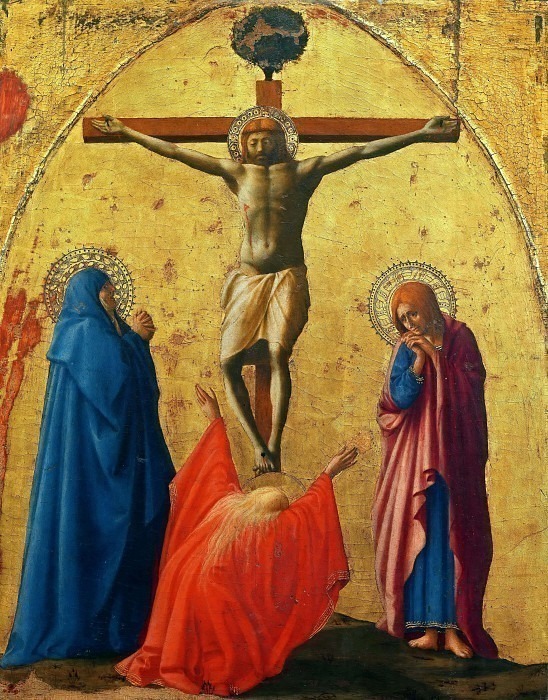Crucifixion Tommaso Masaccio (1401-1428)
Tommaso Masaccio – Crucifixion
Edit attribution
Download full size: 3287×4200 px (3,9 Mb)
Painter: Tommaso Masaccio
Location: Museum Capodimonte, Naples (Museo di Capodimonte).
The Crucifixion painting by the Italian master Masaccio was painted in 1426 to decorate the rooms of the Pisa Chapel of Santa Maria del Carmine. It is the best known and most accurate in terms of dates and costs, since the client, due to the special impression the work made on him, scrupulously documented all the data concerning his commission. In the process of creating the work, at the insistence of the customer, who was a well-known notary in Pisa, Giuliano di Colino, Masaccio used only the most expensive and high-quality materials.
Description of Masaccio’s painting Crucifixion
The Crucifixion painting by the Italian master Masaccio was painted in 1426 to decorate the rooms of the Pisa Chapel of Santa Maria del Carmine. It is the best known and most accurate in terms of dates and costs, since the client, due to the special impression the work made on him, scrupulously documented all the data concerning his commission.
In the process of creating the work, at the insistence of the customer, who was a well-known notary in Pisa, Giuliano di Colino, Masaccio used only the most expensive and high-quality materials. Also, information indicates that the artist used gold leaf in the process.
The scene tells us about the time of the crucifixion of Jesus Christ. At the center of the work is Christ on the cross. To his left is John the Evangelist, dressed in a chiton of blue, and to his right is the grieving Mother of God, dressed in wide robes of blue with a red tunic thrown over them.
Mary Magdalene, stretching out her hands in contrition to her unjustly murdered teacher, is located directly in front of the cross and is only visible to the viewer from the back. Even from this angle, however, it is clear how great is the grief of the woman, who, however, will soon be the first human being to behold the great miracle - the appearance of the Risen Jesus. The painting shows Mary in red robes, hunched over and with her head uncovered.
It is worth noting that the upper end of the cross is crowned with a symbol that signifies a speedy rebirth and gives hope to those who mourn, namely, the Tree of Life.
There is a version that Mary Magdalene was not present in the picture from the beginning. The thing is that the halo above her head visually appears on top of Christ’s feet, which is hardly consistent with a mistake by Masaccio in the initial work on the picture.
At the same time, a restoration in the mid-20th century revealed another interesting fact - under the inscription "Jesus of Nazareth, King of the Jews" was found the very same Tree of Life mentioned above. Who and why removed it from the original composition is still a big mystery.
Another interesting fact: it is likely that originally the picture, to enhance the effect of the towering biblical scene, was supposed to look up from below. This is indicated by the voluminous chest of Christ, as well as the weakly pronounced neck of Mary Magdalene.
Кому понравилось
Пожалуйста, подождите
На эту операцию может потребоваться несколько секунд.
Информация появится в новом окне,
если открытие новых окон не запрещено в настройках вашего браузера.
You need to login
Для работы с коллекциями – пожалуйста, войдите в аккаунт (open in new window).



















You cannot comment Why?
Flanking this central figure are three other individuals arranged in a triangular configuration. To the left stands a woman draped in blue robes, her face etched with sorrow; a halo encircles her head. On the right, another woman, similarly adorned with a halo and wearing pinkish-red garments, appears to be lost in contemplation, her hand raised to her chin in a gesture of grief or despair. Beneath the cross, a figure clad in vibrant red robes gestures upwards towards the crucified man; their expression is difficult to discern definitively but conveys an emotional intensity.
The background consists of a gold leaf surface, which creates a luminous and otherworldly atmosphere. An arched structure frames the scene, drawing attention to the central event while simultaneously suggesting a sense of enclosure or sacred space. The limited palette – primarily consisting of blues, reds, pinks, golds, and dark browns – contributes to the paintings solemnity and reinforces its devotional purpose.
Subtly, the artist employs spatial conventions that flatten the perspective, characteristic of early religious iconography. This lack of depth emphasizes the symbolic nature of the scene over a realistic depiction. The halos surrounding the figures highlight their spiritual significance, elevating them beyond the earthly realm.
The arrangement of the figures suggests a narrative of mourning and witness. The woman in blue embodies profound sorrow, while the figure in red appears to be pleading or interceding on behalf of the suffering man. The overall effect is one of intense emotional weight, intended to evoke empathy and spiritual reflection within the viewer.